The HPLC separation technique is widespread in pharmaceutical and chemical industries where its accuracy, precision and selectivity are important to the research, development, production and quality control of many commercial products. During the 1970s, spherical silica particles rapidly displaced first generation granular particles for analytical applications because they were much easier to prepare into stable columns. The first spherical silicas designed for HPLC appeared commercially as thin porous layers on solid silica cores, but their applications were limited due to very low surface area, phase coverage and retention factors.
Totally porous, spherical silica dominated the HPLC market from the 1980s to the 2000s with average particle size continually decreasing from 10µm to 5µm to 3µm.1,2 The trend towards smaller particles is driven by improved performance in terms of speed, sensitivity, and resolution. Smaller particles, however, require higher operating pressures, and in 2004 instruments were commercialised that could utilise columns prepared with sub-2µm particles. Figure 1 illustrates the chromatographic performance of four typical particle sizes used in HPLC. It is clear from Figure 1 that smaller particles lead to greater efficiency, resolving power and sensitivity.
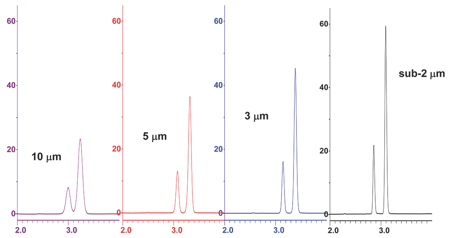
Figure 1: Chromatographic performance for four common particle sizes
Figure 2 illustrates van Deemter plots for the same particle sizes. The plots are height equivalent to theoretical plate (HETP or H) vs mobile phase velocity. The lower the H value the greater the efficiency of a column. An advantage of comparing different columns in a van Deemter plot is that efficiency is plotted as a function of flow rate. While 10µm column performance was attractive in the early 1970s, this efficiency could only be achieved at rather low flow rate. When flow was increased for more assay speed, peaks rapidly became broader and resolution deteriorated, even though pressure was not a limiting factor.
The appearance of 5µm particle columns, with maximum column efficiency of 100,000 plates/metre and flatter van Deemter slope, was a major step toward better resolution and more assay speed. Although benefits of 2µm particle columns to further improve HPLC resolution and speed were clear, progress was slowed by the need for new instrument designs that could easily handle higher pressures and narrower peaks. Generating useful column efficiencies of 200,000 plates/m or greater required new generations of both columns and instruments.
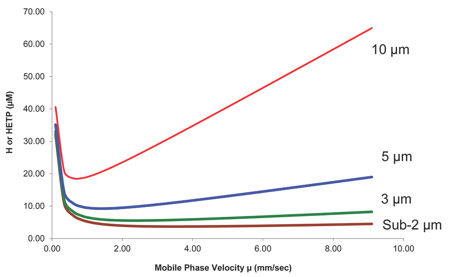
Figure 2: Theoretical van Deemter plots for four common particle sizes
The birth of UHPLC
After 2004, columns with sub-2µm silica became commercially available to extend HPLC performance, but they required new instruments with higher pressure operation (to about 15,000 psi), very low volume flow paths and faster detection. The technique became referred to as Ultra HPLC or UHPLC. While ultra-high performance was now available, it came at a high price. Purchase of a different instrument was needed to use the small particle columns, which were limited to smaller ID geometry and modest flow rates to avoid frictional heat problems.
Moving from HPLC to UHPLC was a difficult decision because not every HPLC assay requires more speed or resolution. It was obvious that sub-2µm particle columns could not be used on traditional HPLC instruments because of the need for more pressure, but it was not obvious that traditional HPLC columns and methods could not be used on UHPLC instruments without method modification. The higher flows common with popular 4.6mm columns exceeded the range of many UHPLC instruments and also resulted in very high instrument background pressure, often higher than the column pressure.
The alternative to UHPLC
As analysts were faced with investing in new instruments to achieve ultra-high performance, partially offset by their reduced versatility and unproven reliability, a new silica particle design was launched that offered many benefits of sub-2µm porous silica, but could operate at traditional instrument pressures. The new particles had a thick porous layer of colloidal silica around a solid silica core; unlike porous silica, they also featured extremely narrow size distribution.
Recently, Fused-Core type columns have appeared commercially for the UHPLC market, attempting to push the performance of the UHPLC market to new heights
The 2.7µm Fused-Core technology particle, commercialised in 2006,3 compared very favorably with a sub-2µm porous particle in efficiency, but operated at the pressure of a 3µm particle, making it suitable for traditional HPLC instruments. Fused-Core column operating pressures were typically about half when compared with sub-2µm particle columns of the same length. This unique characteristic enabled their operation either at higher flows or with longer columns to generate more resolving power.
The reasons for such unique performance from Fused-Core particles are still being studied; however, experts agree that higher performance arises from improvements in all three terms of the van Deemter equation.3 Fused-Core particle columns such as Ascentis Express also proved to be very rugged, demonstrating long column lifetimes, which were attributed to narrow particle distribution and formation of a highly uniform particle bed. Recently, Fused-Core type columns have appeared commercially for the UHPLC market, attempting to push the performance of the UHPLC market to new heights.
Choice, factors and trade offs
No clear winner has emerged in the battle of particle technology. No single particle design is best for every situation. In most cases, both porous and Fused-Core particles can work well if the right stationary phase is available. Even with advances in particle and column efficiency, separation and resolution is still controlled primarily by choice of stationary and mobile phases.
If one chooses to stay primarily with HPLC and 3 and 5µm particle columns, and move cautiously into UHPLC, there are already many excellent choices in porous particles plus a huge database of applications. When higher performance is desired; however, new 5µm Fused-Core particles are now available to provide the performance of 3µm porous particles at very low pressures. If one chooses to move aggressively into UHPLC instruments, columns are becoming increasingly available from all major vendors with new phases prepared on several types of small particles. In addition, the narrow distribution benefit previously limited to Fused-Core particles has recently become available for porous particles.
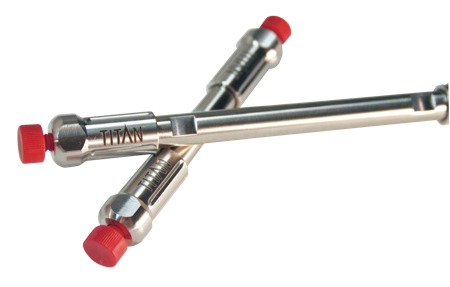
Supelco Titan UHPLC 1.9µm columns
Stationary phases remain important
While the bulk of this article discusses advances in particle technology, one cannot overlook the stationary phase. The stationary phase is generally made up of hydrophobic alkyl chains (-CH2-CH2-CH2-CH3) that interact with the analyte. There are three common chain lengths: C4, C8, and C18. C4 is generally used for proteins and C18 is generally used to separate peptides or small molecules. C18 phases will continue to dominate reversed-phase HPLC and UHPLC; however, there are other stationary phases worth considering.Shown in Figure 3 is a flow chart to help choose a stationary phase when a C18 is not providing adequate resolution. For instance, the RP-Amide phase is a polar embedded phase that can provide very similar performance to a C18 while offering modest selectivity differences for hydrogen-bonding compounds. The F5 phase, which has a pentafluorophenyl pendant group, provides unique steric selectivity for strong dipoles as well as closely related compounds due to steric interactions. Phenyl-Hexyl phases are preferred for their highly selective nature towards heteroaromatics. While most of these phases are suitable ‘plug and play’ options for reversed-phase method development, it should be noted that a few of the phases are very polar and can operate in hydrophilic interaction liquid chromatography (HILIC) mode. HILIC mode is quite different than reversed-phase mode and should be reviewed in the literature before being considered for an application.
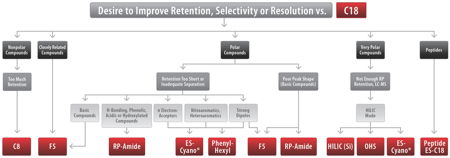
Figure 3: HPLC stationary phase selection flow chart
UHPLC column technology
When experiments showed that some of the performance edge for core-type particles could be attributed to a very narrow particle distribution, new research focused on achieving the same narrow distribution for porous particles.4,5 This has recently been accomplished by the new Ecoporous process that results in monodisperse particles that do not require sizing or classification steps and therefore do not waste particles. One outcome of the Ecoporous process is the recently commercialised Titan UHPLC columns. Figure 4 shows scanning electron micrographs for the Titan UHPLC column particles compared with two other UHPLC particles that have broader particle size distributions. Figure 5 compares columns with 1.9µm Titan C18 and 1.7µm core-type C18 under the same conditions. The Titan column provides the same resolution at lower pressure. Note also that the selectivity for a C18 phase on two different particle types is nearly identical.
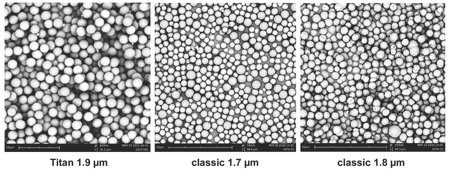
Figure 4: Scanning electron micrographs for three UHPLC porous particles
Ecoporous process monodisperse particles eliminate time-consuming and wasteful aspects and make the particles and columns much more economical. Developments in monodisperse porous particles that have higher efficiency at lower pressure are closing the performance gap between porous and core-type particles, so it seems unlikely that the argument of which is best will be settled soon. In the meantime, suppliers are hedging their bets by offering excellent phase chemistry for both particle types.
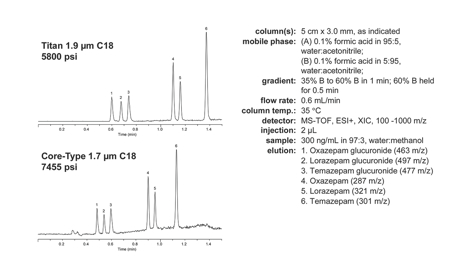
Figure 5: Chromatographic comparison of Titan and Core-type UHPLC columns
UHPLC columns are important developments and must be matched with high performance instruments, where extra-column dispersion and other variables are optimised.6,7 Potential UHPLC advantages include more speed and resolution for assays when 3 and 5µm columns are not adequate. While UHPLC adoption has been rapid in R&D laboratories, manufacturing and production users are exercising caution in adopting UHPLC techniques too quickly for reasons that include:
- Higher initial investment and operating cost
- Unproven ruggedness; higher performance columns and instruments are more difficult to maintain
- Possible negative performance impact of friction heating and other new variables that arrived with UHPLC.
References
1. J. H. Knox and M. Saleem , J. Chromatogr. Sci., 7, 614-622 (1969).
2. M. W. Dong and J. R. Gant, LCGC, 2(4), 294-303 (1984).
3. J. J. Kirkland, T. J. Langlois and J. J. DeStefano, Fused-Core Particles for HPLC Columns, American Laboratory, 39 (February 2007), 18-21.
4. D. Cabooter, A. Fanigliulo, G. Bellazzi, B. Allieri, A. Rottigni, G. Desmet, Relationship between Particle Size Distribution and Chromatographic Performance, J. of Chromatography A, 1217 (2010) 7074–7081.
5. K. Broeckhoven, D. Cabooter and G. Desmet, Kinetic Performance Comparison of Fully and Superficially Porous Particles, Journal of Pharmaceutical Analysis 2013;3(5):313–323.
6. Dorina Kotoni, HPLC 2013 Meeting, Amsterdam Achieving the Highest Efficiency by reduction of the extra-column volume in a UHPLC Instrument
7. R. A. Henry, et. al., Monodisperse Particles, Pittcon 2014, poster #2050-P16.
Ascentis is a registered trademark and Titan and Ecoporous are trademarks of Sigma-Aldrich Co. LLC. Fused-Core is a registered trademark of Advanced Materials Technology, Inc.




